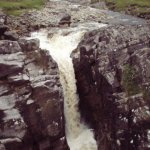Upper Flesk/Clydagh River
| Grade: | 3 to 4 | Rating: |  |
|||
| County: | Kerry | Date updated: | 27/10/2008 | |||
| Section Length: | 6km | Version: | 5 (History) | |||
Brief River Description
This is a more relaxed run than the Middle Flesk but can also be a nice warm up before it. It is a rocky grade 3 river with one section of grade 4 which is considerably more difficult than the rest.
Directions to the Put-in
This Section is above the Middle Flesk. Follow the N22 between Killarney & Cork. Take a left for Clydagh Valley and follow the road to the left. Cross over the bridge at the start of the Middle Flesk and turn right. Follow this road to a small bridge that crosses the river further upstream.
As a local and a paddler I am bemused by the reference to the middle flesk,Upper Flesk.The Flesk proper begins when the Loo and The Clydagh meet at Loo bridge on the Kilgarvan Road.The sectionof the Clydagh between Poul Gorm and The Madam's bridge is known as Killeen Clonkeen.Madam's Bridge to the New Bridge is Derrymaclavode.From here up to the Forestry bridge is Derrynafinna/Knocknabro. From here up is referred to as the top of Clydagh.
Directions to the Take-out
The Take out is before the bridge that runs into the "gates" on the middle Flesk. You can see the last rapid from the bridge. Have a good look at it before heading upstream.
If you do not intend running the Middle Flesk, get out before the bridge. This leads into a twisting class 4 rapid. The easiest get out is on river right, before the small rapid which is visible from the bridge on river right. If you run the rapid exit river right before the bridge, but this involves a climb out of the gorge, needing ropes to shift boats and paddlers.
River Description
This run needs a good bit of water. Depending on the level it can be hard on the equipment and the paddler There is a river gauge which is visible from the bridge at the take out. Anything above 100 and you should be laughing. As the river winds away from the road the gradient picks up. The first section is easy grade 3 paddling.
Further downstream you will meet the first sizable drop which signifies the start of the grade 4 section. The first drop is roughly 7-8ft, which should be shot on river left over a shoot that runs to the right. The second drop is smaller, again run on the left, but requires a quick turn to river right into an eddy above the main fall. This fall is a long rock slide about 25 -30ft long. The water is funneled into a channel with sharp bed rock protruding into the flow.
The remainder of the river is similar to the beginning with several small rapids and drops. The river enters a gorge signaling the take out for the Upper Flesk / Clydagh and the start of the middle Flesk. The easiest exit is on river right before the rapid at the entrance to the gorge. A trickier exit is again on river right after the rapid, but you will require ropes to extract paddlers & boats. If your not confident, get off before the rapid, a swim down the following rapid could be extremely nasty.
If you do not intend paddling the middle Flesk, exit here. the next rapid is a grade 4 that curves to the left.
If your continuing on to the middle Flesk check out the guide on it for more details.
Local issues
The get out is through a farmer's field, as always respect his fences/gates. The bridges at both the get on and off are quite narrow and used by farm machinery so park on the road beside them.
River level gauge
See the Gauge visible from the bridge at the get out. Above 70 is runnable with a scrap or two. Above 100 should be a good paddle.
If the river level is very high (> 2m on gauge) then take a drive up to the main drop and see if you like it.The main drop excellent at 2.5mIt turns into a big volume rapid that is over real fast or real slow. Its worth knowing the river so that you can make the last takeout before the bridge. The Middle Flesk is mean at this level.
Author(s)
Original Author: CiaranLatest Author: John Lynch
(Full History)
Please add river details by adding to/editing the guide.


